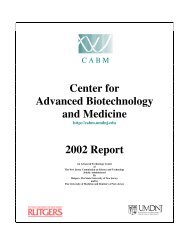Annual Report 2011 - Center for Advanced Biotechnology and ...
Annual Report 2011 - Center for Advanced Biotechnology and ...
Annual Report 2011 - Center for Advanced Biotechnology and ...
You also want an ePaper? Increase the reach of your titles
YUMPU automatically turns print PDFs into web optimized ePapers that Google loves.
Dr. Mengqing Xiang<br />
CABM Resident Faculty Member<br />
Professor<br />
Department of Pediatrics<br />
UMDNJ-Robert Wood Johnson<br />
Medical School<br />
Dr. Kangxin Jin<br />
Postdoctoral Associate<br />
Dr. Shengguo Li<br />
Research Teaching Spec.<br />
Dr. Huijun Luo<br />
Research Teaching Spec.<br />
Dr. Kamana Misra<br />
Research Teaching Spec.<br />
Min Zou<br />
Graduate Student<br />
Molecular Neurodevelopment Laboratory<br />
Dr. Mengqing Xiang came to CABM in September 1996 from the Johns<br />
Hopkins University School of Medicine where he conducted postdoctoral<br />
studies with Dr. Jeremy Nathans. He earned his Ph.D. at the University of<br />
Texas M.D. Anderson Cancer <strong>Center</strong> <strong>and</strong> has received a number of honors<br />
including a China-U.S. Government Graduate Study Fellowship, a Howard<br />
Hughes Medical Institute Postdoctoral Fellowship, a Basil O’Connor Starter<br />
Scholar Research Award <strong>and</strong> a Sinsheimer Scholar Award. In 2003 he<br />
received the Award in Auditory Science from the National Organization <strong>for</strong><br />
Hearing Research Foundation. His work is currently supported by NIH.<br />
Our laboratory investigates the molecular mechanisms that govern the determination<br />
<strong>and</strong> differentiation of the highly specialized sensory cells <strong>and</strong> neurons. We employ a<br />
variety of molecular genetic approaches to identify <strong>and</strong> study transcription <strong>and</strong> other<br />
regulatory factors that are required <strong>for</strong> programming development of the retina, inner<br />
ear, spinal cord, <strong>and</strong> other CNS areas. A major focus of our work is to develop<br />
animal models to study the roles of these regulatory genes during normal<br />
sensorineural development, as well as to elucidate how mutations in these genes<br />
cause sensorineural disorders such as blindness <strong>and</strong> deafness.<br />
Generation of a transgenic line <strong>for</strong> studying V2 neuronal lineages <strong>and</strong> functions<br />
in the spinal cord. During spinal neurogenesis, the p2 progenitor domain generates<br />
at least three subclasses of interneurons named V2a, V2b <strong>and</strong> V2c, which are crucial<br />
components of the locomotor central pattern generator. We have previously shown<br />
that the winged-helix/<strong>for</strong>khead transcription factor Foxn4 is expressed in a subset of<br />
p2 progenitors <strong>and</strong> required <strong>for</strong> specifying V2b interneurons. To determine the cell<br />
lineages derived from Foxn4-expressing progenitors, we generated a Foxn4-Cre<br />
BAC transgenic mouse line that drives Cre recombinase expression, mimicking<br />
endogenous Foxn4 expression pattern in the developing spinal cord. We used this<br />
transgenic line to map neuronal lineages derived from Foxn4-expressing progenitors<br />
<strong>and</strong> found that they gave rise to all neurons of the V2a, V2b as well as the newly<br />
identified V2c lineages. These data suggest that Foxn4 may be transiently expressed<br />
by all p2 progenitors <strong>and</strong> that the Foxn4-Cre line may serve as a useful genetic tool<br />
not only <strong>for</strong> lineage analysis but also <strong>for</strong> functional studies of genes <strong>and</strong> neurons<br />
involved in locomotion.<br />
35



